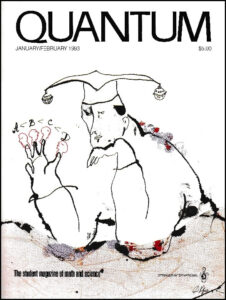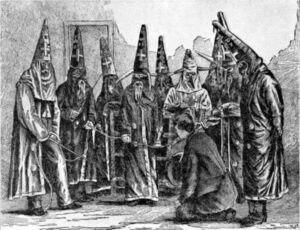The following puzzle appeared in the October/November 2023 issue of the AARP member magazine.
What’s next?
Each number after the first is derived in the same way from the previous number. What is the number that logically follows 66?
1, 6, 21, 66, ____
Before we get to their solution, I’ll explain mine. (It turns out it is not technically correct, but I only realized that while I was typing the problem just now.)
In trying to get the number after 66, I worked from the differences between each of the preceding three pairs of numbers. What I came up with was: the difference between the first two numbers is 5 × 30; the difference between the second and third is 5 × 31; the difference between the third and fourth is 5 × 32. I figured the difference between the fourth number and the (currently unknown) fifth is 5 × 33, or 135, which would make the fifth number 66 + 135 = 201.
That indeed is the correct answer to the question “what is the next number in this sequence?” But my approach does not satisfy the condition exactly. My approach is systematic and sequential, but the operation is not the same throughout the process—I’m increasing the power by increments of 1 at each step. I’m not deriving the number “in the same way” from the previous number, which I (and probably you) take to mean “doing the same exact operation over and over.” The correct solution is the one they give: “For each number after the first, multiply by 3, then add 3.” Getting the right answer (appropriate number) is not the same as coming up with the “correct” solution (solving method).
Here’s the thing: I find their solution ugly. It looks like someone scratched out an equation, any old equation, made a sequence using it, and gave us the sequence for us to reverse engineer. Big whoop. Is mine more elegant? I’ll let the reader be the judge. Theirs can be stated more briefly than mine, but it seems like something a solver would have to arrive at by trial and error. What was my approach? Well, when I noticed that the difference between the first two numbers is 5 and that between the second and third is 15, it got me thinking about 5 as a factor to be investigated. The rest, as they say, is history.
What has me baffled now is the fact that two such divergent approaches both work. The next number in the sequence is identical using each approach:
(3 × 201) + 3 = 606 [AARP],
201 + (5 × 34) = 201 + 405 = 606 [TMW].
Presumably it will continue to be so. How are the two approaches related? How do I start solving this problem?
We know that
x0 = 1, x1 = 6, x2 = 21, x3 = 66 …
We can say that
xn+1 = (xn × 3) +3 [AARP]
is equivalent to
xn+1 = xn + (5 × 3n) [TMW],
where n is the position in the sequence, beginning at 0—i.e, the first number x0 = 1. (I may be butchering the proper mathematical presentation of my thinking, but them’s the breaks.)
This gets me wondering if the equations continue to produce equivalent results if we start at, say, 2. Excuse me while I check … It does not!
2, 9, 30, 93 … [AARP]
is obviously not the same as
2, 7, 22, 67 … [TMW].
Well, well. But despair not: maybe we just need to tweak the first equation—make it, say,
xn+1 = (xn × 3) +1 [AARPrev.1].
(Since, in the second slot, we need to get 7 instead of 9, let’s add 1 instead of 3 after multiplying.) We’ll let my equation stay as is. It seems rather less “fixable” than the other. When we start the sequence with 2, the revised AARP equation yields
2, (2 × 3) + 1 = 7, (7 × 3) + 1 = 22, (22 × 3) + 1 = 67 … [AARPrev.1].
Bingo! What if we start with 3? Let’s run my equation first:
3, 8, 23, 68 … [TMW].
Can we adjust the AARP equation to get this sequence? How about xn+1 = (xn × 3) – 1 (since we need to get 8 now in the second slot)?
3, (3 × 3) – 1 = 8, (8 × 3) – 1 = 23, (23 × 3) – 1 = 68 … [AARPrev.2].
So, to generalize, if we start the sequence with 1, the AARP equation adds 3 after multiplying by 3; if we start with 2, it adds (3 – 2) = 1; if we start with 3, it adds (1 – 2) = –1 (i.e., we start subtracting from now on, still in increments of 2). So, starting with 4:
4, 9, 24, 69 … [TMW],
4, (4 × 3) – 3 = 9, (9 × 3) – 3 = 24, (24 × 3) – 3 = 69 … [AARPrev.3].
This is all very nice, but I don’t feel that I’m any closer to seeing how the two equations relate. We incrementally add 1 to the starting number, but incrementally subtract 2 from the number we add in the AARP equation, quickly getting us into adding negative numbers (subtracting, although the fact we’re subtracting now seems a trivial, maybe merely accidental detail, of interest only to those who freak out when “positives” become “negatives”). One senses a connection, but I’m too mathematically dull to find it.

Michael H. Brill and Michael Stueben explored “A Magnificent Obsession: The Strange Story of Perfect (and Perfectly Useless) Numbers” in the January/February 1993 issue of Quantum. (Cover by Dmitry Krymov, illustrating a different article)
It’s curious that adding 1 to the starting number in the sequence simply adds 1 to all the numbers in the sequence. It’s obvious why this happens in the TMW equation: the numbers worked out in the parentheses never change, only the numbers added to them change (by 1, because the starting number changed by 1). That’s the beauty of not changing my equation! The behavior of the AARP equation is a bit more convoluted, but it gets to the same point as the TMW equation: all the numbers increase by 1. It apparently has to do with always multiplying by 3 but adding 2 less every time we change the starting number, but I can’t quite get a handle on how to explain it mathematically. (The more I think about it, the more it seems this is the sort of problem routinely encountered, and solved, in computer programming.)
Situations like this make me sad that number theory was never offered during my many years of incarceration—I mean, education. While editing Quantum I would encounter all sorts of interesting mathematical “genres” that I had never seen before: topology, group theory, non-Euclidean geometry, etc. Maybe one of these would have triggered something in me, in a way that calculus certainly did not. It may be that I was not suited for any of those other areas of mathematics either. In any case, a problem like this little teaser in an Old Fogey magazine gave me a fun few minutes shimmying up to the edge of real mathematics and gazing agape into the abyss.
 Maybe you can come up with the English translation on your own. But let’s assume you can’t, or don’t care to try, so we can get right to it (and not hide it in the comments). Here it is:
Maybe you can come up with the English translation on your own. But let’s assume you can’t, or don’t care to try, so we can get right to it (and not hide it in the comments). Here it is:









